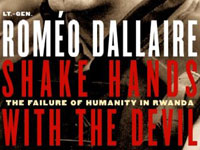|
text k videu
Deset let po genocidě ve Rwandě se filmový štáb v čele s kanadským dokumentaristou Peterem Raymontem vydal do Afriky na inkriminovaná místa. Doprovázel generála ve výslužbě Roméa Dallaira, který zde jako pověřenec mezinárodní vojenské síly Spojených národů selhal. V naprosté bezmocnosti zabránit katastrofě, s nedostatečnou pomocí, za pasivního přihlížení světové veřejnosti.
V roce 1994 zde zahynulo během stodenního masakru 800 000 lidí ve střetu dvou opozičních etnik: extremisté Hutuové vraždili Tutsie. Otřesený Dallaire zodpovědně přijal břemeno viny za brutální masové vraždění, zbaven navždy klidu v duši (dvakrát se pokusil o sebevraždu) a odsouzen k mukám nespavosti a k černým můrám. Po letech vypovídá na místech prožité hrůzy. Ve filmu jsou kombinovány archivní snímky z masakru se současnou situací ve Rwandě.
Vždy máme možnost rozhodnout se podle svého svědomí... - Ovšem ani brigádní generál Romeo Dallaire, hrdina tohoto dokumentu, který v roce 1994 velel mírové misi OSN ve Rwandě, nemohl zabránit hrůzostrašné genocidě, při níž zahynulo 800 000 Afričanů.
An informant tells Gen. Dallaire about the Hutu extremists’ extermination plans. But Kofi Annan‘s U.N. peacekeeping office is skeptical; Annan tells Dallaire not to raid arms caches and avoid using any force.
Seeing that no action is being taken by Dallaire’s U.N. forces, the extremists are now confident that the U.N. won’t stand in their way. On April 6th the Rwanda president’s plane is shot down and the killing begins. Dallaire again requests U.N. guidance and again is told to avoid armed conflict.
As the slaughter intensifies, the International Red Cross mission in Rwanda does not leave, and its leader, Philippe Gaillard, soon finds himself having to confront the extremist regime.
Meanwhile, a Rwandan human rights activist travels to Washington to meet with officials and ask for stronger U.S. action. But as she is there lobbying, the U.S. and the entire U.N. Security Council vote to withdraw 90% of Gen. Dallaire’s forces.
Four weeks into the genocide the Red Cross has estimated that 300,000 Rwandans have already been killed. The Clinton administration leaves the handling of the crisis to an interagency working group whose hands are tied by the government’s policy of non-intervention.
As the world leaves Rwanda to its fate, a young U.N. peacekeeper, Capt. Mbaye Diagne, is saving hundreds of lives, and Gen. Dallaire, the U.N. force commander, is confronting the death squad commanders.
As the years pass, world leaders Đ who did little as genocide happened on their watch Đ came to places like Nyarabuye on pilgrimages of contrition. Eventually, President Clinton himself comes to Rwanda.
Soon after the killing began, Carl Wilkens, an Adventist missionary, put his wife and children on a U.S. convoy out of Rwanda. But he decided to stay behind with Rwandan colleagues and workers who’d sought refuge in his home. By the night of April 10th, he was the only American left in Rwanda.
The first three weeks, the violence forced Wilkens to stay in his house and he videotaped and talked about what he was seeing and hearing. Later, he ventured out each day to help save lives by bringing supplies to orphanages and negotiating with the extremists. He remained in Rwanda throughout the genocide.
Subscribe Now & Visit us:
Websites:
naijanedu.com,
tv.naijanedu.com
|
x

Filmová adaptace knižní předlohy Romea Dallaire z roku 2007 - v originále nazvaná Shake Hands with the Devil. Kniha popisuje cestu autora v době Rwandské genocidy v roce 1994. O tom, jak velitel mírové mise Dallaire požadoval pomoc pro oběti genocidy a byl ignorován OSN.
Druhý film je o genocidě v Súdánském Dárfúru.
|
